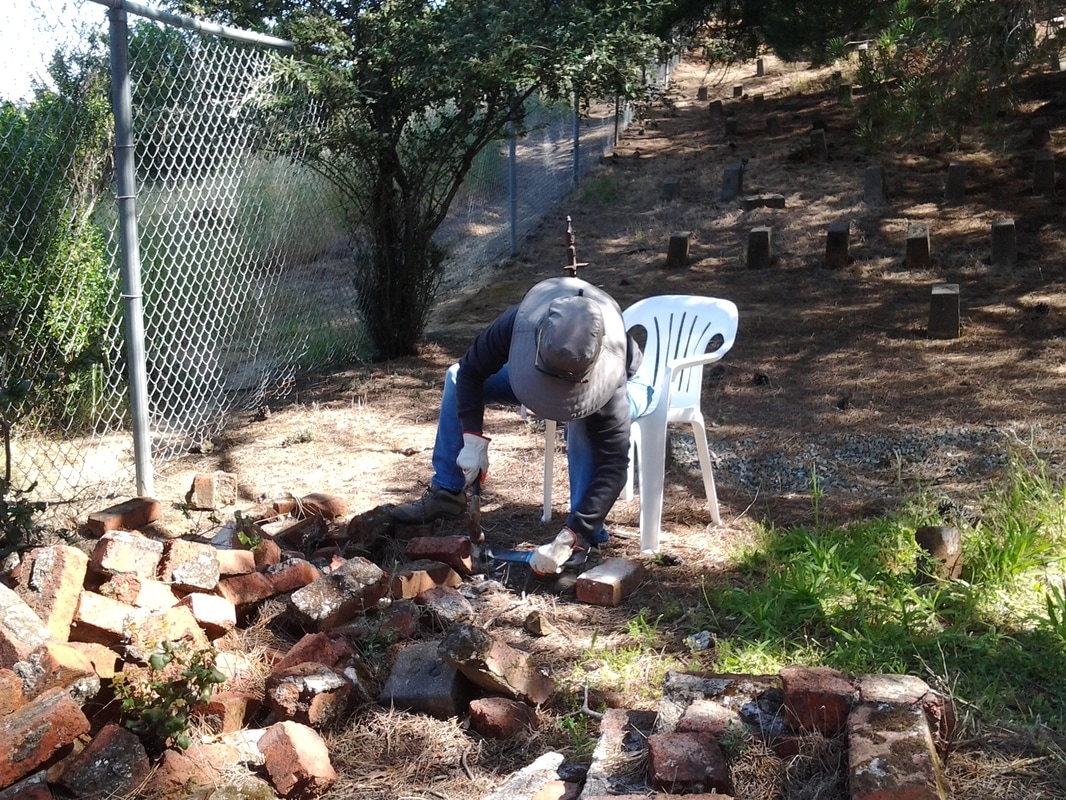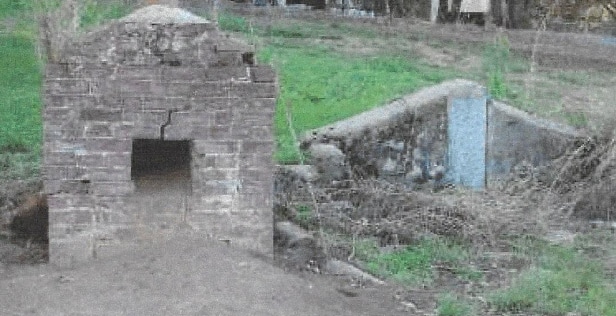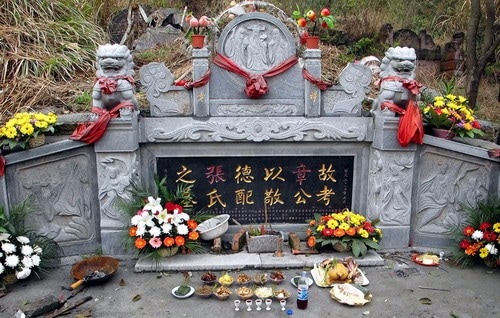This Article was published in the Martinez News-Gazette on 5/03/2017The Potter’s Field Restoration Project began five years ago, when we were approached to rebuild the Chinese Funerary Burner located in Potter’s Field. To learn more regarding its history and use we started by researching Chinese immigration to California, their customs and rituals. We discovered that the ancient ritual of “tomb-sweeping” and the Alhambra Cemetery Cleanup days have much in common. Chinese immigration to California began in 1815 with the first large wave occurring in 1852. According to Wikipedia, “By 1848, there were 325 Chinese Americans. There were 323 more immigrants in 1849, 450 in 1850 and 20,000 in 1852 (2,000 in 1 day). By 1852, there were 25,000; over 300,000 by 1880: a tenth of the Californian population.” We met with Sonia Ng and Roland Hui, renowned local Chinese-American historians specializing in Chinese-American cemeteries, customs and structures. Sonia mentioned there was a sizable Chinese community by the turn of the Century due to finding several Chinese businesses in an international Chinese business directory dated 1913. However, during the gold rush boats and ferries were the major transportation from SF to Sacramento with Martinez as a strategic stopping point, thereby potentially sparking a much earlier Chinese community. Regarding the burner itself we found the website “Chinese Funerary Burners: A Census” compiled by Terry Abraham from the University of Idaho. He states, “The most common singular feature of overseas Chinese cemeteries and of the Chinese section of host community cemeteries is the "burner" (sometimes erroneously called "oven"). These brick or masonry structures, often over seven feet tall (approx. 2.1 m), serve as a safe place for the ritualized burning of spiritual tributes. These paper and cardboard facsimiles of money, clothing, possessions, and houses, for example, are to serve the deceased in the afterlife. Burning these simulacra passes them to the spirit realm …” Further research into the burner’s uses led us to the “Qingming Festival” held over the course of three days beginning on the 15th day from the Spring Equinox, which usually falls on either April 4th or 5th. The origins of the Qingming (“pure bright”) Festival incorporates the happiness of renewal (spring) and the sadness of remorse. Spring is a time when nature decides to wake up and take action. Trees and plants burst fragrant, pastel blossoms and young green leaves emerge on branches. It is a time to stop “hibernating” from the cold, dormant winter, and do some “spring cleaning” while getting out and enjoying the sunshine. It is an important holiday also called Tomb-Sweeping or Ancestors Day as it is a time to remember their ancestors by taking care of their graves. It’s said that the Qingming Festival was started 2,500 years ago as commemoration of a loyal defender, Jie Zitui, who sacrificed a portion of his own body to save his lord, Duke Wen in exile. When Duke Wen regained his rightful position, he wanted to reward Jie Zitui for his loyalty. However being a humble man, he hid with his mother in a mountain to avoid recognition. Duke Wen ordered the mountain to be set on fire to draw him out; instead he murdered both Jie Zitui and his mother. Filled with remorse, Duke Wen ordered a new festival with no fire for three days. This began the Hanshi (Cold Food) Festival, where only cold food could be served. On the next Hanshi Festival, Duke Wen went to honor Jie Zitui at his tomb. He found a burnt willow tree bursting with growth and immediately ordered that the day after become known as Qingming. Today the Qingming Festival is a combined celebration of both holidays with many outdoor activities that represent remembrance and rebirth. Much like the Alhambra Cemetery Cleanups, the descendants conducted “tomb-sweeping” by clearing debris around the gravesite, removing weeds and dusting the headstones. They also prayed before their ancestor while offering tea, wine, chopsticks, joss paper, and favorite cold foods for them to enjoy in the afterlife. In the Buddhist tradition, willow branches are placed near the grave or altar to protect their ancestors from evil spirits. As mentioned before, the funerary burner was used to burn imitation mortal items made of paper. Sonia told us that during the 1800s, Chinese immigrants wanted to be buried in their ancestral homeland where they were born. Their dead were buried in the US, for seven to ten years to decompose the body, and then the bones exhumed, ceremonially cleaned, placed inside an iron box, shipped back to China and reburied in their village. A Taoist priest giving prayers to the earth deity on behalf of the decease’s family began this ritual. In most US Chinese cemeteries, an altar took the place of a temple and was used for the offerings of fruit, wine, flowers and incense by the family or clan. Once again, the burner was used during the exhumation ritual. Sonia stated that the altar held the most reverence in relation to its location. It would have included clan information engraved on a memorial wall or large headstone erected to all those left behind. Unfortunately, there is no trace of the Alhambra Cemetery’s altar and no pictorial evidence of the original burner at this time. Which leaves us with some important questions to ask: What did the burner look like? Could there be remnants of an older structure underneath its foundation? Are there remnants of the altar yet to be discovered? As we make progress, we will submit articles on its restoration. For more information on this story, please visit our website martinezcemetery.org. If you would like to participate in a little “tomb-sweeping”, the next Alhambra Cemetery Cleanup is Saturday, May 13th from 10 am – 2 pm. Wear comfortable clothing and bring a pair of gloves. Feel free to bring a camp chair if you have one. Lunch provided by E. Clampus Vitus, with morning refreshments provided by the Potter’s Field Restoration Project. If you have any information or pictures regarding the burner and altar, please email us at [email protected] or call us at (925) 316-6069.
Judie & Joseph Palmer are two of the founding members of the Martinez Cemetery Preservation Alliance (MCPA) and the Potter’s Field Project. Both have a passion for discovery, history, genealogy, anthropology and archaeology. For more info, please visit our website MartinezCemetery.org. Do you have a Potter’s Field story to tell? We welcome any pictures or information regarding the Alhambra Pioneer Cemetery or its Potter’s Field. Please email us at [email protected] or call us at (925) 316-6069. |
AuthorsJudie & Joseph Palmer are two of the founding members of the Martinez Cemetery Preservation Alliance (MCPA) and the Potter’s Field Project. Both have a passion for discovery, history, genealogy, anthropology and archaeology. Archives
October 2021
Categories |






 RSS Feed
RSS Feed